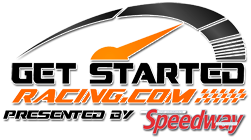The only way your expensive race car should contact the race track is through the contact patch of each tire. Proper alignment and settings of the front tires affect how they work with the rear ones. And since four tires make better traction than two or three, making all four work will maximize corner speed. Heck, eight tires make even better side bite than four, but if you race that way much, you’ll be spending a lot of time trying to stay out of fights after the races.
The easily adjusted, but important settings for front end alignment include caster, camber, toe, and bump steer.
Caster
If you were to look straight down at the upper ball joint, caster is the amount that it is either in front (negative) or behind (positive) the lower ball joint. Positive caster provides stability in the steering and tends to help self-align the front wheels which helps eliminate wandering of the steering. Think of the front forks on a motorcycle: the more chopper-like, the more stable; the closer the handlebars are to being positioned directly over the center of the front wheel, the twitchier it is.
Positive caster also can be used to improve handling. More positive caster in the right front means that during counter steer (as if you were getting loose) the spindle attempts to rotate forward due to the force being applied to the steering arm by the tie rod. This gives you feedback or “feel” in the steering. What’s more, turning to the right with substantial amount of caster raises that corner and loads the left rear.
A similar effect occurs on the left front when you turn the wheel to the left. Positive caster on the left front will provide steering feel and will load the right rear corner as you steer the car into the corner. This can help keep the car tighter on corner entry. It’s a good idea to run a couple of degrees less caster on the left front than the right front because it helps the car naturally steer itself to the left, which is the way we want to turn in the first place.
Caster
The tops of both tires should be “tilted” to the left (the infield when the car is on the track) for a natural tendency for the car to turn to the left. Running the proper amount of camber helps to keep the maximum amount of the contact patch of the front tires on the race track as the car corners. To see if you need more or less camber, look at tire wear and tire temperatures across the surface of each front tire. Simply, the more evenly both the temperature and tire wear are distributed, the closer to optimum our front end settings are. You should also consider that the optimum settings may be different on a flat track than they are on a high banked track, so make sure you keep good notes on what settings work the best for the different tracks you go to.
Toe
If we have zero toe, the front wheels are both pointing perfectly straight ahead. Toe setting is important because it helps provide feel in the steering and can help with stability on the straightaway. If you have zero or very little toe, the car will typically feel “twitchy” or “darty”, especially if you are on a track that is very fast or has long straights. This is due to the fact that there is some inherent looseness in all of your front end components which will cause the car to feel unstable as you race down the straightaway. The front tires will try to turn the car left or right as they experience bumps or imperfect spots in the track surface. Most racers run toe out to counteract this and make the car feel more stable. Typical toe settings are in the 1/8” to ¼” range, with most chassis manufacturers specifying toe out. Dirt cars typically run at least ¼” toe out or more, up to 5/8” in some cases. Increasing toe out will increase drag when the car is going straight because the front tires won’t be aligned perfectly straight with the direction of travel. So why is toe important? Not enough and the car is heading all over the place down the straightaway. Too much and you are scrubbing off speed down the straightaway. Toe setting can be easily thrown off if you race on a rough track or if you bang wheels with someone, so make sure you check your toe setting as part of your weekly routine, and especially if you’ve made contact. If your toe setting has changed significantly, you need to make sure you determine the cause because something is bent on your front end.
Bump Steer
Bump steer is defined as the amount that the steering arm on the spindle moves either in or out as the front suspension “bumps” or travels, typically in compression. Bump out means that the front wheel actually toes out farther as the front suspension is compressed. Bump in is the opposite. Bump steer should be minimized. It is better to have some bump out as the suspension compresses. This helps maintain stability by not canceling out the toe setting as the car corners.
